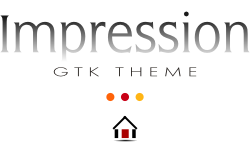ImpressionGtkTheme
|
Home Page |
Impression-ism was a 19th-century art movement that began as a loose association of Paris-based artists exhibiting their art publicly in the 1860s. The name of the movement is derived from the title of a Claude Monet work, Impression, Sunrise (Impression, soleil levant), which provoked the critic Louis Leroy to coin the term in a satiric review published in Le Charivari. Characteristics of Impressionist painting include visible brush strokes, open composition, emphasis on light in its changing qualities (often accentuating the effects of the passage of time), ordinary subject matter, the inclusion of movement as a crucial element of human perception and experience, and unusual visual angles.
Launchpad
Screenshots
Series and Milestones
Kyūdō Approach
Kyūdō is the Japanese art of archery. From it we derive the thought that an optimal result follows from an optimal process.
The current goal of Project Kyūdō is to create an optimal theme for the Ubuntu GNU/Linux distribution. In the long run, the theme should be the central piece in an effort to achieve an optimal presentation.
Due to this being a community effort, we don't have the decision power to put things into place. We will offer an alternative and intend to convince by delivering high quality work resulting from a traceable process.
Impression - Kyūdō Briefing
Top Level
- Enhance the user computing experience by applying balance and harmony to the Gnome Desktop framing applications in such a manner as to permit the eye to focus without distraction on the content displayed. The desire is an optimal result from an optimal process.
Target Audience
- Ubuntu is used by a broad spectrum of individuals, this solution is targeted toward those who spend a significant amount of their professional or personal day at their computer.
Assumptions
Some level of customization may be required
Although the desire is to craft a very usable solution it is assumed some will need to change the result to better suite theirs needs. Reasons include but are not limited to:- Personalization to achieve user satisfaction and enhance usability
- Satisfy physical differences in vision and/or color perception
- Compensate for environmental differences and viewing conditions
- Accommodate hardware differences
The Pareto Principle
Known as the 80-20 rule, the law of the vital few and the principle of factor sparsity states that, for many events, roughly 80% of the effects come from 20% of the causes. It is assumed at any given moment the desire of the user will be to focused on an area of the screen which is less than the total amount of available.
Asthenopia and Poor Design
Many computer users experience Asthenopia or visual stress due to:- an increase in the number and complexity of necessary eye movements and focusing skills
- poor lighting conditions, glare and distracting reflections
- screen flicker rate
extended amount of computer use
Performance Is Built-in
It is assumed using a robust theme engine like Murrine will provide acceptable performance metrics.
Transparency to Applications
- To be transparent, your eyes should not be drawn to the window frame or the supporting control widgets. Control widgets should be available in a manner which enhances usability and are easily identified as needed.


